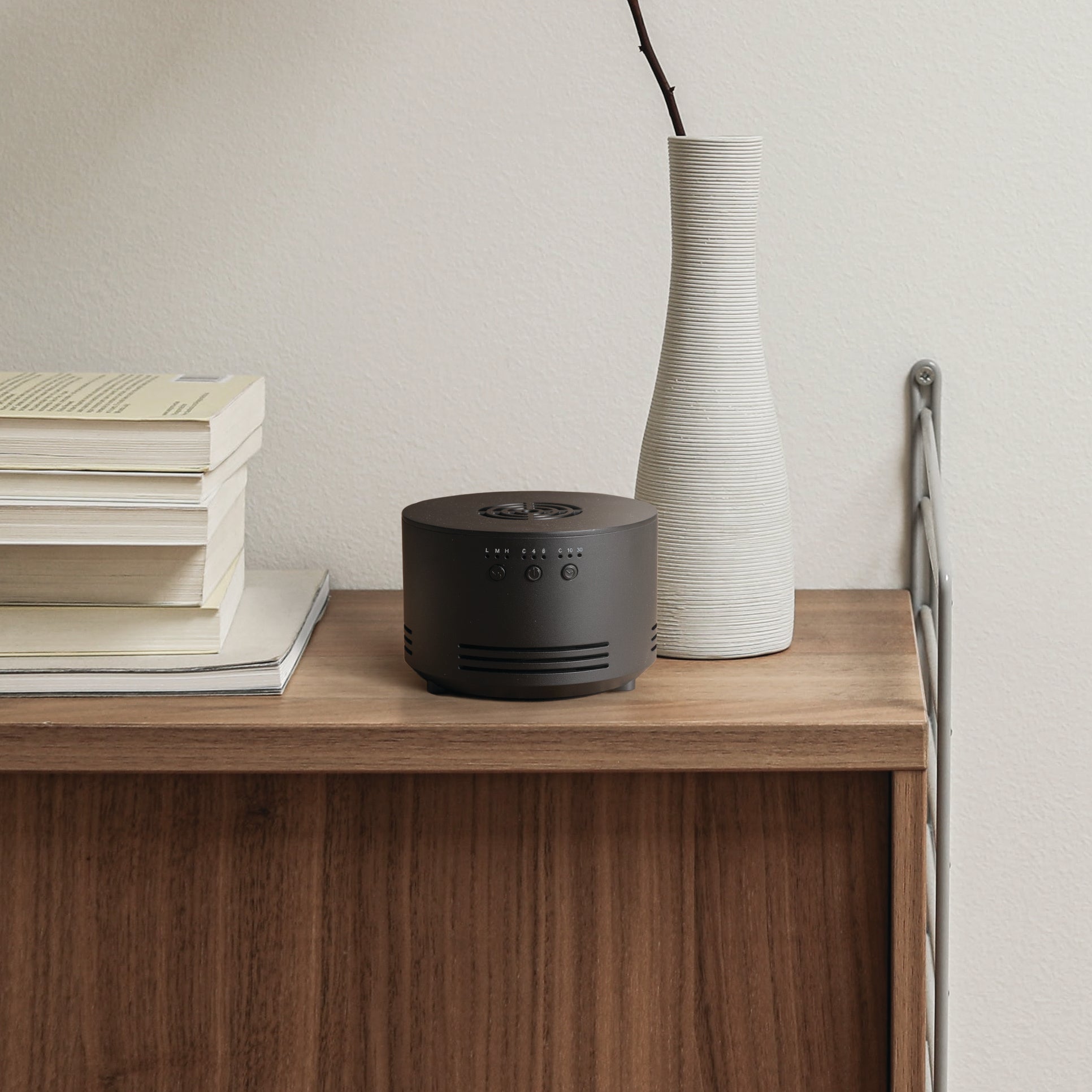Ascents® Focus No. 04: Research Abstracts for Component Oils
Modulation of cognitive performance and mood by aromas of peppermint and ylang-ylang.
Int J Neurosci. 2008 Jan;118(1):59-77.
Moss M(1), Hewitt S, Moss L, Wesnes K.
Author information:
(1)Human Cognitive Neuroscience Unit, Division of Psychology, University of Northumbria, Newcastle upon Tyne, United Kingdom. mark.moss@unn.ac.uk
This study provides further evidence for the impact of the aromas of plant essential oils on aspects of cognition and mood in healthy participants. One hundred and forty four volunteers were randomly assigned to conditions of ylang-ylang aroma, peppermint aroma, or no aroma control. Cognitive performance was assessed using the Cognitive Drug Research computerized assessment battery, with mood scales completed before and after cognitive testing. The analysis of the data revealed significant differences between conditions on a number of the factors underpinning the tests that constitute the battery. Peppermint was found to enhance memory whereas ylang-ylang impaired it, and lengthened processing speed. In terms of subjective mood peppermint increased alertness and ylang-ylang decreased it, but significantly increased calmness. These results provide support for the contention that the aromas of essential oils can produce significant and idiosyncratic effects on both subjective and objective assessments of aspects of human behavior. They are discussed with reference to possible pharmacological and psychological modes of influence.
PMID: 18041606 [PubMed - indexed for MEDLINE]
Modulation of cognitive performance and mood by aromas of peppermint and ylang-ylang.
Int J Neurosci. 2008 Jan;118(1):59-77. Moss M(1), Hewitt S, Moss L, Wesnes K.
Summary: This study provides further evidence for the impact of the aromas of plant essential oils on aspects of cognition and mood in healthy participants
Conclusion: Peppermint was found to enhance memory whereas ylang-ylang impaired it, and lengthened processing speed. In terms of subjective mood peppermint increased alertness and ylang-ylang decreased it, but significantly increased calmness. These results provide support for the contention that the aromas of essential oils can produce significant and idiosyncratic effects on both subjective and objective assessments of aspects of human behavior.
Protective effect of menthol on β-amyloid peptide induced cognitive deficits in mice.
Eur J Pharmacol. 2012 Apr 15;681(1-3):50-4. doi: 10.1016/j.ejphar.2012.01.035.
Epub 2012 Feb 7.
Bhadania M(1), Joshi H, Patel P, Kulkarni VH.
Author information:
(1)Department of Clinical Pharmacology, Max Neeman Medical International Ltd., New Delhi., India. mitalbhadania@yahoo.com
Cognitive impairment is a multidimensional concept that subsumes the attention and concentration, learning and memory, problem-solving ability, visuospatial abilities, mental flexibility, psychomotor efficiency and manual dexterity. The intrinsic mechanisms of the behavioural effects may involve neuronal damage in the brain structure. A lower concentration of glutamate receptor co-agonists in the striatum indicates the general malfunction of the brain glutamatergic system. It is suggested that a selective decrease in hippocampal glutamate concentration may account for deterioration in learning and memory process, considering the important role of this neurotransmitter in the cognitive functions. Nootropic agents like piracetam and anticholinesterase inhibitors are commonly used for improving memory, mood and behaviours. The present study was undertaken to assess the nootropic potential of menthol on learning and memory employing exteroceptive and interoceptive behavioral model in young and aged mice. To delineate the mechanism by which menthol decreases cognitive impairment and protect the brain, various biochemical parameters such as brain glutamate, glycine, glutathione and thiobarbituric acid reactive substances were determined. Menthol produced significant improvement in learning and memory. Menthol exhibited excellent antioxidant effect and maintain glutamate concentration in various region of the mouse brain for management of preliminary symptoms of memory impairment.
Copyright © 2012 Elsevier B.V. All rights reserved.
PMID: 22329901 [PubMed - indexed for MEDLINE]
Effects of bergamot (Citrus bergamia (Risso) Wright & Arn.) essential oil aromatherapy on mood states, parasympathetic nervous system activity, and salivary cortisol levels in 41 healthy females.
Forsch Komplementmed. 2015;22(1):43-9. doi: 10.1159/000380989. Epub 2015 Feb 19.
Author information:
(1)Department of Immunology, Kyoto Prefectural University of Medicine, Kyoto, Japan. Watanabe E(1), Kuchta K, Kimura M, Rauwald HW, Kamei T, Imanishi J.
BACKGROUND: Bergamot essential oil (BEO) is commonly used against psychological stress and anxiety in aromatherapy. The primary aim of the present study was to obtain first clinical evidence for these psychological and physiological effects. A secondary aim was to achieve some fundamental understanding of the relevant pharmacological processes.
METHODS: Endocrinological, physiological, and psychological effects of BEO vapor inhalation on 41 healthy females were tested using a random crossover study design. Volunteers were exposed to 3 experimental setups (rest (R), rest + water vapor (RW), rest + water vapor + bergamot essential oil (RWB)) for 15 min each. Immediately after each setup, saliva samples were collected and the volunteers rested for 10 min. Subsequently, they completed the Profile of Mood States, State-Trait Anxiety Inventory, and Fatigue Self Check List. High-frequency (HF) heart rate values, an indicator for parasympathetic nervous system activity, were calculated from heart rate variability values measured both during the 15 min of the experiment and during the subsequent 10 min of rest. Salivary cortisol (CS) levels in the saliva samples were analyzed using ELISA.
RESULTS: CS of all 3 conditions R, RW, and RWB were found to be significantly distinct (p = 0.003). In the subsequent multiple comparison test, the CS value of RWB was significantly lower when compared to the R setup. When comparing the HF values of the RWB setup during the 10 min of rest after the experiment to those of RW, this parameter was significantly increased (p = 0.026) in the RWB setup for which scores for negative emotions and fatigue were also improved.
CONCLUSION: These results demonstrate that BEO inhaled together with water vapor exerts psychological and physiological effects in a relatively short time.
© 2015 S. Karger GmbH, Freiburg.
PMID: 25824404 [PubMed - in process]
Citrus bergamia essential oil: from basic research to clinical application.
Front Pharmacol. 2015 Mar 2;6:36. doi: 10.3389/fphar.2015.00036. eCollection 2015.
Navarra M(1), Mannucci C(2), Delbò M(3), Calapai G(2).
Author information:
(1)Department of Drug Sciences and Products for Health, University of Messina
Messina, Italy. (2)Department of Clinical and Experimental Medicine, University
of Messina Messina, Italy. (3)Italian Medicines Agency Rome, Italy.
Citrus bergamia Risso et Poiteau, also known as "Bergamot," is a plant belonging to the Rutaceae family, defined as a hybrid of bitter orange and lemon. It is an endemic plant of the Calabria region (Italy). Bergamot fruit is primarily used for the extraction of its essential oil (bergamot essential oil: BEO), employed in perfume, cosmetics, food, and confections. The aim of this review was to collect recent data from the literature on C. bergamia essential oil and, through a critical analysis, focus on safety and the beneficial effects on human health. Clinical studies on the therapeutic applications of BEO exclusively focus on the field of aromatherapy, suggesting that its use can be useful for reducing anxiety and stress.
PMCID: PMC4345801
PMID: 25784877 [PubMed]
Full PDF: http://www.ncbi.nlm.nih.gov/pmc/articles/PMC4345801/pdf/fphar-06-00036.pdf
The role of essential oils in the treatment and management of attention deficit hyperactive disorder.
International Journal of Aromatherapy
Heather Godfrey, BSc
Abstract
This paper reflects the results of a qualitative study recently undertaken by the author, in which the consequences of attention deficit hyperactive disorder (ADHD) and the validity of employing essential oils [including frankincense] as a complementary therapy to assist in its management were explored. The original study involved six semi-structured interviews with the parents of boys aged 11–14 years. The subjects attended Wennington Hall (EBD) School, having been Statemented as presenting with emotional and behavioural difficulties, in particular, ADHD: (section 168 of the Education Act 1993 and the Education (Special Educational Needs) Regulation 1994). A literature search was conducted and experts in the field of aromatherapy were questioned.
Based on the results of this project, a synthesis of research, opinion and experience has been presented here: first exploring the aetiology and consequences of ADHD; then discussing the use of essential oils within this context. The author concluded that essential oils could have a valid role in the management of ADHD, and presented the results gleaned from her research study and personal experience with the intention of assisting fellow professional aromatherapists, parents, teachers, carers and potential researchers.
Aromas of rosemary and lavender essential oils differentially affect cognition and mood in healthy adults.
Int J Neurosci. 2003 Jan;113(1):15-38.
Moss M(1), Cook J, Wesnes K, Duckett P.
Author information:
(1)Human Cognitive Neuroscience Unit, Division of Psychology, Northumberland
Building, University of Northumbria, Newcastle upon Tyne, NE1 8ST, UK.
mark.moss@unn.ac.uk
This study was designed to assess the olfactory impact of the essential oils of lavender (Lavandula angustifolia) and rosemary (Rosmarlnus officinalis) on cognitive performance and mood in healthy volunteers. One hundred and forty-four participants were randomly assigned to one of three independent groups, and subsequently performed the Cognitive Drug Research (CDR) computerized cognitive assessment battery in a cubicle containing either one of the two odors or no odor (control). Visual analogue mood questionnaires were completed prior to exposure to the odor, and subsequently after completion of the test battery. The participants were deceived as to the genuine aim of the study until the completion of testing to prevent expectancy effects from possibly influencing the data. The outcome variables from the nine tasks that constitute the CDR core battery feed into six factors that represent different aspects of cognitive functioning. Analysis of performance revealed that lavender produced a significant decrement in performance of working memory, and impaired reaction times for both memory and attention based tasks compared to controls. In contrast, rosemary produced a significant enhancement of performance for overall quality of memory and secondary memory factors, but also produced an impairment of speed of memory compared to controls. With regard to mood, comparisons of the change in ratings from baseline to post-test revealed that following the completion of the cognitive assessment battery, both the control and lavender groups were significantly less alert than the rosemary condition; however, the control group was significantly less content than both rosemary and lavender conditions. These findings indicate that the olfactory properties of these essential oils can produce objective effects on cognitive performance, as well as subjective effects on mood.
PMID: 12690999 [PubMed - indexed for MEDLINE]
Effect of aromatherapy on patients with Alzheimer's disease.
Psychogeriatrics. 2009 Dec;9(4):173-9. doi: 10.1111/j.1479-8301.2009.00299.x.
Jimbo D(1), Kimura Y, Taniguchi M, Inoue M, Urakami K.
Author information:
(1)Department of Biological Regulation, School of Health Science, Faculty of
Medicine, Tottori University, Yonago, Japan.
OBJECTIVE: Recently, the importance of non-pharmacological therapies for dementia has come to the fore. In the present study, we examined the curative effects of aromatherapy in dementia in 28 elderly people, 17 of whom had Alzheimer's disease (AD).
METHODS: After a control period of 28 days, aromatherapy was performed over the following 28 days, with a wash out period of another 28 days. Aromatherapy consisted of the use of rosemary and lemon essential oils in the morning, and lavender and orange in the evening. To determine the effects of aromatherapy, patients were evaluated using the Japanese version of the Gottfries, Brane, Steen scale (GBSS-J), Functional Assessment Staging of Alzheimer's disease (FAST), a revised version of Hasegawa's Dementia Scale (HDS-R), and the Touch Panel-type Dementia Assessment Scale (TDAS) four times: before the control period, after the control period, after aromatherapy, and after the washout period.
RESULTS: All patients showed significant improvement in personal orientation related to cognitive function on both the GBSS-J and TDAS after therapy. In particular, patients with AD showed significant improvement in total TDAS scores. Result of routine laboratory tests showed no significant changes, suggesting that there were no side-effects associated with the use of aromatherapy. Results from Zarit's score showed no significant changes, suggesting that caregivers had no effect on the improved patient scores seen in the other tests.
CONCLUSIONS: In conclusion, we found aromatherapy an efficacious non pharmacological therapy for dementia. Aromatherapy may have some potential for improving cognitive function, especially in AD patients.
PMID: 20377818 [PubMed - indexed for MEDLINE]
Neuropharmacology of the essential oil of bergamot.
Fitoterapia. 2010 Sep;81(6):453-61. doi: 10.1016/j.fitote.2010.01.013. Epub 2010
Jan 20.
Bagetta G(1), Morrone LA, Rombolà L, Amantea D, Russo R, Berliocchi L, Sakurada S, Sakurada T, Rotiroti D, Corasaniti MT.
Author information:
(1)Department of Pharmacobiology and University Centre for Adaptive Disorders and
Headache, Section of Neuropharmacology of Normal and Pathological Neuronal Plasticity, University of Calabria, Arcavacata di Rende, CS, Italy. g_bagetta@virgilio.it
Bergamot (Citrus bergamia, Risso) is a fruit most knowledgeable for its essential oil (BEO) used in aromatherapy to minimize symptoms of stress-induced anxiety and mild mood disorders and cancer pain though the rational basis for such applications awaits to be discovered. The behavioural and EEG spectrum power effects of BEO correlate well with its exocytotic and carrier-mediated release of discrete amino acids endowed with neurotransmitter function in the mammalian hippocampus supporting the deduction that BEO is able to interfere with normal and pathological synaptic plasticity. The observed neuroprotection in the course of experimental brain ischemia and pain does support this view.
In conclusion, the data yielded so far contribute to our understanding of the mode of action of this phytocomplex on nerve tissue under normal and pathological experiments and conditions and provide a rational basis for the practical use of BEO in complementary medicine. The opening of a wide venue for future research and translation into clinical settings is also envisaged.
Copyright (c) 2010 Elsevier B.V. All rights reserved.
PMID: 20093169 [PubMed - indexed for MEDLINE]
Menthol enhances phasic and tonic GABAA receptor-mediated currents in midbrain periaqueductal grey neurons.
Benjamin K Lau1 *, Shafinaz Karim1,2*, Ann K Goodchild2 , Christopher W Vaughan1 and Geoffrey M Drew1 1 Pain Management Research Institute, Kolling Institute of Medical Research, Northern Clinical School, The University of Sydney at Royal North Shore Hospital, St Leonards, NSW, Australia, and 2 Australian School of Advanced Medicine, Macquarie University, North Ryde, NSW, Australia
Correspondence Dr Benjamin K Lau, Pain Management Research Institute, Level 13 Kolling Building, Kolling Institute of Medical Research, The University of Sydney at Royal North Shore Hospital, St Leonards, NSW 2065, Australia. E-mail: benjamin.lau@sydney.edu.au
*These authors contributed equally to this work.
Accepted 19 January 2014
BACKGROUND AND PURPOSE Menthol, a naturally occurring compound in the essential oil of mint leaves, is used for its medicinal, sensory and fragrant properties. Menthol acts via transient receptor potential (TRPM8 and TRPA1) channels and as a positive allosteric modulator of recombinant GABAA receptors. Here, we examined the actions of menthol on GABAA receptor-mediated currents in intact midbrain slices.
EXPERIMENTAL APPROACH Whole-cell voltage-clamp recordings were made from periaqueductal grey (PAG) neurons in midbrain slices from rats to determine the effects of menthol on GABAA receptor-mediated phasic IPSCs and tonic currents. KEY RESULTS Menthol (150–750 μM) produced a concentration-dependent prolongation of spontaneous GABAA receptor-mediated IPSCs, but not non-NMDA receptor-mediated EPSCs throughout the PAG. Menthol actions were unaffected by TRPM8 and TRPA1 antagonists, tetrodotoxin and the benzodiazepine antagonist, flumazenil. Menthol also enhanced a tonic current, which was sensitive to the GABAA receptor antagonists, picrotoxin (100 μM), bicuculline (30 μM) and Zn2+ (100 μM), but unaffected by gabazine (10 μM) and a GABAC receptor antagonist, 1,2,5,6-tetrahydropyridin-4-yl)methylphosphinic acid hydrate (TPMPA; 50 μM). In addition, menthol potentiated currents induced by the extrasynaptic GABAA receptor agonist THIP/gaboxadol (10 μM).
CONCLUSIONS AND IMPLICATIONS These results suggest that menthol positively modulates both synaptic and extrasynaptic populations of GABAA receptors in native PAG neurons. The development of agents that potentiate GABAA-mediated tonic currents and phasic IPSCs in a manner similar to menthol could provide a basis for novel GABAA-related pharmacotherapies. Abbreviations CNQX, 6-cyano-7-nitroquinoxaline-2,3-dione; THIP, 4,5,6,7-tetrahydroisoxazolo[5,4-c]pyridin-3-ol hydrochloride, gaboxadol; TPMPA, 1,2,5,6-tetrahydropyridin-4-yl)methylphosphinic acid hydrate; TTX, tetrodotoxin BJP British
Journal of Pharmacology DOI:10.1111/bph.12602 www.brjpharmacol.org





